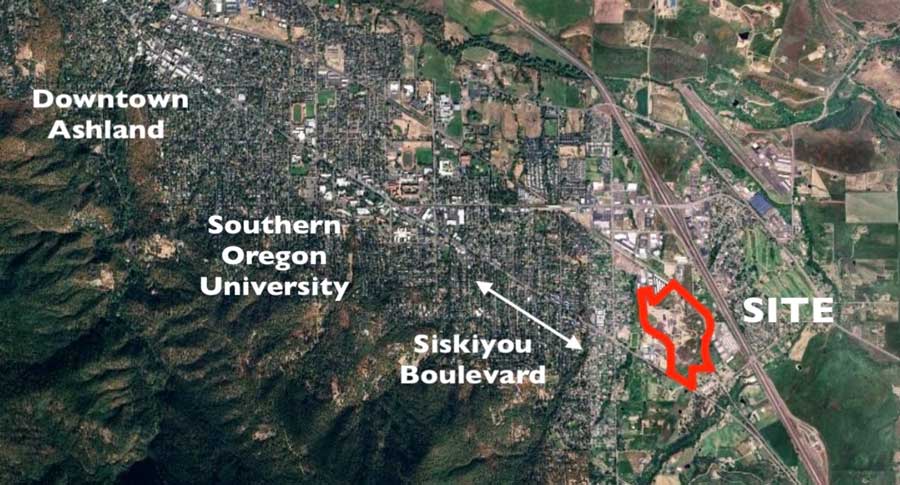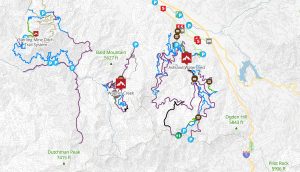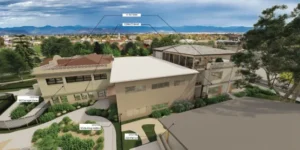600-page application filed for Ashland Mill, former Croman Mill site
By Craig Breon for Ashland.news
Derek Severson, Ashland’s planning supervisor, now faces more than 600 pages’ worth of an application from Townmakers, the developer of Ashland Mill, the largest project ever proposed in the city. Understandably daunted, he also acknowledges the rare opportunity this provides for him and other planners in a city of Ashland’s size.
The mixed-use project plan shows 538 residential units plus 200,000 square feet of commercial and light-industrial spaces on 61 acres of land in Ashland’s southeast. The Croman timber mill operated on the site for six decades, but the land has been unused now for 30 years.
After three and a half years of planning, Severson’s current schedule predicts planning commission hearings beginning February 2026 and City Council hearings starting March or April 2026, with final action likely by next summer. These dates may slip, however, given the number of issues this project raises: housing needs, transportation, climate concerns, wetlands and contaminated soils, to provide a partial list.

Part of the city’s Croman Mill District, the site has been planned for industrial and other job-producing sites since 2010, but those priorities have changed. The changes will require new zoning and associated ordinances as well as a complex development agreement — a kind of contract between a city and one or more developers rarely seen in Ashland but fairly common for large projects in many communities.
The main advantage of a development agreement involves timing. According to Severson, a developer is typically required to begin construction within 18 months from the date of project approval, and if that time expires, an additional approval can be required. The development agreement can extend that time period up to 15 years. Ashland Mill is expected to be built in phases over several years, a timeline typical for a project of its size.
Severson expects phase one, focusing on the center of the site, to begin construction within one to two years from approval, and phase two, closer to Siskiyou Boulevard, to begin after the two-year mark.
Whether Townmakers will develop the site itself or sell portions of the land and accompanying development rights to other development companies is uncertain. Even if sold to others, the approved site design guidelines would ensure that the overall look of the area remains consistent.

The discussion around housing will likely dominate the upcoming public hearings. Townmakers’ proposal depicts a mixture of units including single family detached, single family attached (such as townhouses or duplexes), accessory dwelling units (called carriage houses by Townmakers) and apartments. The proposed mix of single family to apartments is nearly 50/50, but this may change as the project winds through public input and likely negotiations between the city and Townmakers.
The city has limited ability to require affordable units on the site, though Townmakers’ representatives emphasize that the range of housing types and sizes will naturally provide diverse price points.
Approximately 10 acres of the site must be annexed to the city, and state law allows Oregon cities to require a percentage of affordable units when land is being annexed. That should lead to eight affordable units. Ashland’s current ordinances also allow the city to require a certain amount of affordable housing when, as here, land is being rezoned, leading to perhaps another 41 units, thus totaling 49.
Townmakers, however, believes they can provide a larger number of affordable units by working with affordable housing builders to access outside funding. They are currently in discussions with at least four such builders. Townmakers’ planner Michael Mehaffy states that they will “shoot for” 25% affordable units overall, but the funding is crucial.
Federal funding is questionable, given the Trump administration’s cuts to housing programs. State and local funding sources exist. Such funds often depend on how “affordable” the proposed units will be. Typically measured against the Area Median Income (AMI), a proposal of units available to those earning 60% of AMI would typically have more access to funding than the same number of units at 100% of AMI, although 100% might still be considered affordable when compared to market rate housing.
Review the application
The Community Development Department has posted the Ashland Mill application at ashlandoregon.gov/1146/Ashland-Mill-PA-T3-2025-00015. Readers may want to start with Section 2, the Ashland Mill Master Plan Application, which includes narrative summaries of existing site conditions and key master plan elements.
Learn more at an open house
Townmakers will host an Ashland Mill open house from 5:30 to 7:30 p.m. Wednesday, Dec. 10, at the Historic Ashland Armory, 208 Oak St.
With a project of this size, Planner Severson stated, “I wouldn’t be surprised if [Townmakers] come in with multiple affordable housing providers.”
On the commercial and industrial side of the development, Townmakers is currently in discussion with other parties to create a roughly 25,000-square-foot area they refer to as a wellness center. Michael Weinstock, who heads Townmakers, notes that those discussions are, “not far enough along to be specific,” but believes such a center would fit well with the Ashland vibe.
A grocery store is also under discussion. Weinstock emphasizes that such a store would be “a very different offering” from Albertsons or Shop’n Kart, both located nearby.
Townmakers’ Mehaffy hopes the eventual development agreement can maintain some flexibility to adapt to future circumstances and opportunities. He acknowledges that the dynamic between building houses to create local business demand and building businesses to provide services for local housing is, “a little bit of a chicken-and-egg thing.”
The Croman Mill site property owner, Dwain & Bud LLC, is currently conducting a clean-up process for contaminated soils and potential water contamination in several areas. This process is guided by the Oregon Department of Environmental Quality (DEQ), and the city is essentialy an observer, with little control over the process. Townmakers has hired its own environmental engineer to peer review the clean-up effort.
While the Croman Mill site is largely disturbed due to decades of use for timber operations, there remains small amounts of wetlands and an intermittent creek on the site. Two ponds on the property and the creek are proposed to be retained. Other micro wetlands, less than .1 acres, may be developed in exchange for expanding or enhancing wetlands in other areas, either on- or off-site.
Townmakers is currently in discussions with the Rogue Valley Transportation District (RVTD), focused on a bus line. Severson at the planning office says the city is not involved in these discussions, and he has “no idea” of whether a bus line can be included given recent RVTD service cutbacks. Severson does note, however, that the RVTD bus stop next to Bi-Mart is the busiest stop in the RVTD system.
Email Jackson County resident, consultant and former environmental law instructor Craig Breon at [email protected].
Related stories:
Formal application filed for former Croman Mill site development (Nov. 9, 2025)
Study could serve as a guide for future Ashland business development (April 24, 2025)
Ashland’s Climate Friendly Area discussion focuses on Railroad Property and Transit Triangle (Oct. 29, 2024)
Public open house Tuesday focuses on Climate Friendly Areas (Sept. 15, 2024)
Council agrees: A denser Ashland would make more city more ‘liveable’ (July 18, 2024)
Council Corner: We need to develop the city’s Southside (March 15, 2024)
Croman Mill development moving briskly forward (Feb. 10, 2024)
Council looks at progress on key Croman Mill site (Nov. 8, 2023)
Ashland close to designating Climate Friendly Areas for development (Sept. 15, 2023)
Croman Mill site needs cleanup, but figures to be major new Ashland neighborhood — eventually (Aug. 7, 2023)
Ashland’s ‘Climate Friendly Neighborhood’ focus falls on Croman Mill, railroad properties (April 15, 2023)
Ashland Past Times: A town of many mills (May 23, 2022)




















